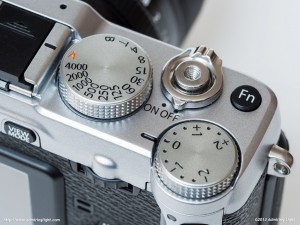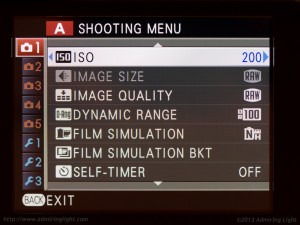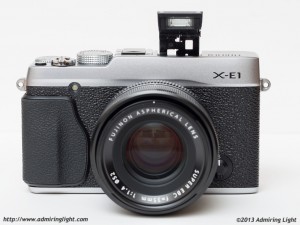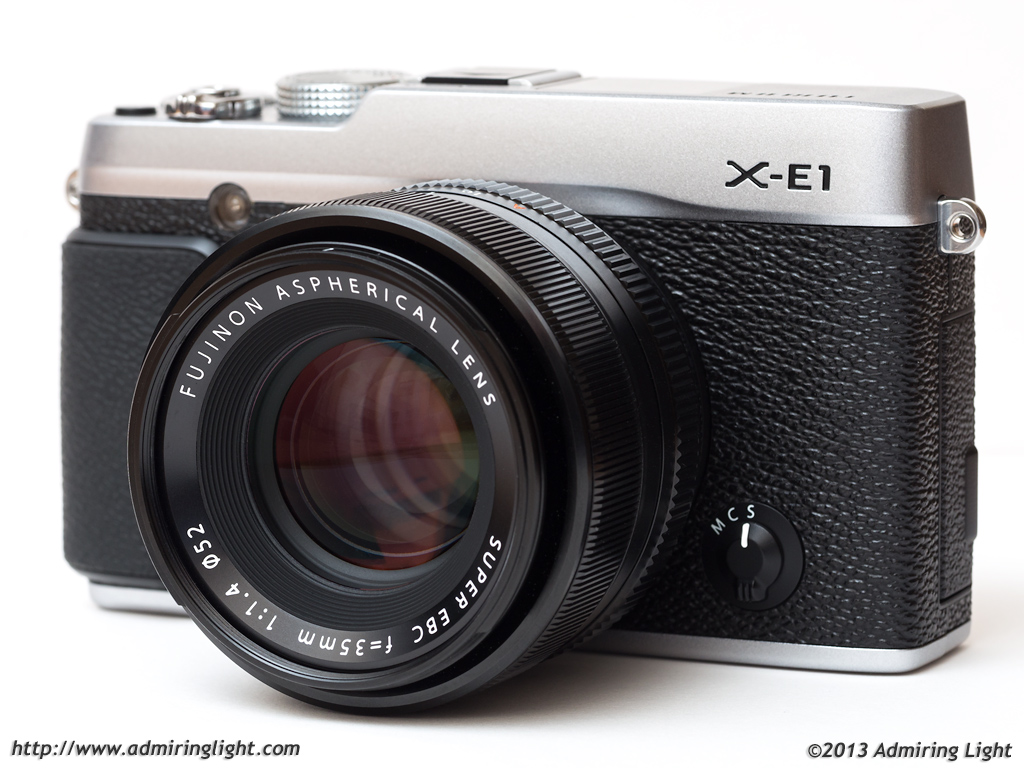Contents
Operation and Menus

The ‘retro’ look is very ‘in’ nowadays, with the success of the Olympus OM-D being a notable example. Fuji, however, takes the retro theme all the way to the controls. While there are certainly a nice array of digital controls and menus to customize the experience, the X-E1 (and the X system as a whole) uses the same control scheme as those cameras that it apes aesthetically.
Namely, the main controls are an aperture ring that is on each lens and a dedicated shutter speed dial. The shutter speed settings are in one stop increments, but 1/3 stop settings can be accessed if desired by pressing left or right on the 4-way buttons to go faster or slower from the speed on the dial. All aperture rings on all Fuji lenses operate in 1/3 stops. Both the aperture rings and shutter speed dial have an ‘A’ designation to set that parameter to automatic. As a result, there is no need for a mode dial. To use Aperture priority, set the shutter speed dial to ‘A’ and select the aperture you want. Shutter priority works the opposite way. Set both to ‘A’ for program mode and select both parameters for full manual. The one update to this paradigm is the addition of a dedicated exposure compensation dial that is easily accessible by the right thumb.
These dials make operating the Fujifilm X-E1 an absolute joy. All settings are instantly visible at a glance, even when the camera is off. It’s so intuitive, that I’m simply amazed that no other manufacturers have gone back to this paradigm after it first went away in the late 80s.

The menus in the X-E1 are well-organized and easy to navigate. There are five sections of shooting parameters and three general camera setup sections. Because the interface is so intuitive, there isn’t a whole lot to customize, but that’s OK. There is one programmable function button that sits right next to the shutter button that can be set to change a number of different parameters, though I’d imagine most shooters will set it to change ISO. Holding that button down will bring you straight to the menu item to set what that button controls…this is a nice touch.
The rear of the camera has a number of controls, with the AFL/AEL button just to the right of the thumb rest and above the Q button, which brings you straight to the camera’s “Quick Menu,” which allows you to change a number of the most needed items, such as JPEG parameters, file quality and format and so on.
The left side of the LCD contains the AF point selection button, which brings up the grid of 35 selectable focus points covering the entire frame. The size of the AF points can be quickly changed by using the secondary dial, which sits just to the left of the thumb rest.
Also on the left is the Drive button, which allows you to switch from single shot, burst, bracketing and contains the switch into video mode. The fact that video is hidden here tells you how much this is a stills oriented camera.
The front of the camera has the focus selection switch, allowing you to quickly switch between single shot and continuous autofocus as well as manual focus without taking your eye from the camera.
Overall, the controls on the Fujifilm X-E1 are simply and fast to operate, and more than any other camera, I love picking up this camera and shooting with it for this reason alone. However, it’s not all roses in operation.
Autofocus and Performance
If there’s one Achilles heel about the Fuji X-E1 it’s the autofocus system. While Fuji has made big strides in this area since the initial release of the X-Pro 1 (which had essentially unusable autofocus that actually locked up the live feed of the sensor during autofocus), the X-E1’s AF is well behind its two major competitors in Micro 4/3 and Sony’s NEX.
The autofocus speed of the X-E1 is fairly decent in good light, though it’s not going to break any records, especially with the 35mm f/1.4. In dim light, AF can range from acceptable to downright awful. With lots of contrast and a fast lens, the AF is OK. When things are a little less contrasty, the AF speed becomes quite slow and will often fail to find focus at all, displaying a red AF box with “AF!” displayed. And by lower contrast, I mean a person’s eyeball that’s in partial shadow. While the camera trains the operator over time (I have learned subconsciously where to focus for optimal results, so over time, the number of AF failures I’ve had has decreased quite a bit), it’s still way, way behind something like the Olympus OM-D E-M5, which can lock nearly instantaneously and super accurately in the situations where the X-E1 throws up its hands. If I’ve been shooting with the X-E1 for a while and I pick up my OM-D, I am blown away by the absolute speed and responsiveness of the Olympus in comparison.
Update, Firmware v2.0: Fujifilm has made great strides in Autofocus speed and low light accuracy with firmware version 2.0. While still not as fast as the autofocus present in modern Micro 4/3 cameras or Sony NEX cameras, it’s not that far behind. Low light focusing has been dramatically improved with this latest firmware version and the camera is now able to lock focus in most any shooting situation. The frustrating AF failures of earlier firmware versions appear to be a thing of the past, and the Fuji X-E1 now sports a quite decent single shot autofocus system.
The continuous autofocus of the X-E1 is also essentially unusable. Instead of acting like typical continuous AF and tracking a subject when pressing the shutter button, it continuously focuses, regardless of whether the shutter is half pressed or not. The speed here makes it more a feature in name than in actually usefulness.
There is a little shutter lag with the X-E1, but it’s not generally a big deal. The camera can shoot 6 frames per second in burst mode, and this works well if you are prefocusing and shooting a series of shots. Don’t count on using the X-E1 as a sports camera in most situations. It’s definitely a more deliberate camera, and performs well in this scope.
Flash

The X-E1 has a very nicely hidden pop-up flash that hides next to the standard ISO hotshoe on top of the camera. A button on the rear of the camera pops the flash up and out of the body. Like all built-in flashes, it’s not particularly powerful, but it does just fine for fill-in work or times when you don’t have an external flash handy. Exposure with the fill-in flash is generally accurate. The mechanism also allows you to hold the flash back to provide for bounce flash in the horizontal position, though you’ll need to up the ISO a bit if you’re using a slower lens when bouncing the built in flash.


This is a very thorough review! Thanks.
I find the Fuji X cameras very photography focused. When I pick my Canon dslr, or a P&S, even a m4/3 I feel I need to look at menus, options, change settings. With my X-E1 I can just pick it up and shoot.
I never really thought I would like manual controls, but they just “feel” right.
Love my X-E1 and both the 18-55 and the 35. I find myself using this camera and lens combo much more often now than my D700, or D800. Who wants to carry a dSLR if they don’t have to? Not me.
I still use the D700 and D800 for tripod work, and weddings but I would not hesitate to take the X-E1 to an event.
Thanks for the review. It is not all rosy — especially the focus issue. I also did not see the “seam” issue on my X-E1 body that you show in your images. That’s weird. Maybe they fixed this QC issue?
Later,
J
For Jorg!
Love my X-E1 and as 18-55 and 35.
See the difference in picture detail if you shoot at 35 mm focal length lens (XF18-55mm F2 ,8-4 R LM) against XF35mmF1.4 R.
Sincerely,
Victor
I think it is a major quirk that you need to press the AF-Button in order to be able to move the focus area.
While looking through the EVF this is just awkward.
The AE-Button is somewhere between my nose and my cheek and I have a hard time to find it without taking the camera down.
Don’t you have the same problem?
I do say ” The only odd ergonomic item is the positioning of the AF button, which is a little awkwardly placed at the left edge. I’d have prefered a top plate or thumb accessible button for this, so that it was easier to change the focus point while the viewfinder is up to your eye.”
You are right, sorry, I missed that one.
However why do I need an extra button?
On my 7D I can move the focus points without pressing any extra buttons.
Even if I have to press an extra button: The buttons up, left and right of the selector all already taken, but the button down is available: Pressing the down button once enters the focus selection mode.
I just hope somebody at Fuji reads your blog and changes that in the next firmware update.
BTW: You have created some truly beautiful pictures for this review!
What I’d really like is for them to put a touch screen on the back in addition to direct focus point adjustment. I originally thought it was a gimmick, but having owned several touch screen cameras now, it’s truly great to just be able to touch where you want the focus point to be. Even bringing the camera down from your face it’s fast to switch. (Note I’m not wanting a touch screen instead of direct button controls (never), but in addition to…
My biggest hope for the next firmware update (aside from continuing to improve AF) is the fixing of the magnification problem, where you can’t magnify an image in manual focus if the camera is writing to the card. It kills me when I use an adapted lens.
Hi Jordan, great review! I just bought Sonar 90 and have not yet bought the adapter, could you tell me what are you using? Thanks
I’m using a cheap e-bay adapter that looks like a knockoff of the Kipon adapter. It works fine. It turns easily, but can stick a little bit throughout the range. The longer you leave it on, though, the smoother it gets. If you want really smooth focusing, I hear the metabones is the way to go, but it’s heavy and expensive.
Great review, thank you. I am strongly leaning towards a purchase of the X-E1. Fuji has very recently released a software update to address focus issues with both the ProX1 and the X-E1. Was your review with the new update? If not will you be updating and letting us know if it makes as significance a difference as Fuji indicates on their website. Thanks
I’ve been shooting with the latest firmware since I got the camera (1.04). All lenses are up to date as well. The next update that was recently announced won’t be available until the May-July timeframe. If there is a significant change, I’ll update the review at that time.
I’ve been excruciatingly patient in holding off on purchasing one of the new Fuji X-Series cameras. However, this one is starting to talk to me in a big way. Your honest review with not only the good points, but the dirt too, is really an informational dream. I’m still limited on my budget, but I think I can swing into a body-only XE-1 for $600-$700 if I’m just a little patient about it. I find that there is an M42 adapter available, and my old but amazing Zeiss Ultron 50/1.7 screw mount ought to do well in carrying the image to the sensor. Thank you for one of the better reviews I’ve read anywhere.
Hi Jordan. I’m very glad to read this detailed review. If you don’t mind, i’m wonder that what did you apply on first photo above in ps? Thank you.
The latest firmware solves the problem of the awkward placement of the AF button on the lower left of the Fujifilm X-E1. You now have two other choices; the FN button can be programmed to serve that function, as can the lower arrow in the 4-way controller. The latter seems the better choice. Just one click on the lower arrow to open up the focus point screen, then your finger is already in position to make adjustments. It works smoothly.
Yes indeed. That is why, when Firmware 1.06 was released, I added the following text to the review: “Update: With firmware v.1.06, Fuji has added the ability for the down arrow on the four-way controller to act as a programmable function button. By default, this is set to control focus area selection. The Fn button can also now be programmed to allow for focus area selection. Having AF point selection on the down arrow makes selecting the focus point tremendously easier when shooting. Thanks, Fuji!”
Thanks for the nice reviews. They are always well written and supported by some fine images.
I am considering the XE-1 + 27mm f2.8 both of which you have reviewed. One of the reasons is the cropped 1:1 aspect ratio it offers, as an easy alternative to shooting 6×6 film . One question though, how does the cropped 1:1 aspect ratio affect the focal length of the lenses?